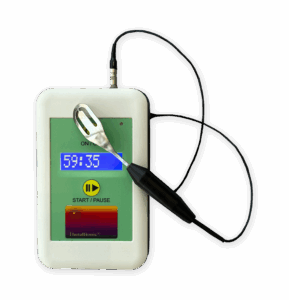The Fibrolamellar Cancer Foundation is pleased to announce that it has awarded an exploratory research grant to Dr. Hugo Jimenez at Wayne State University to investigate the effectiveness of using low energy electromagnetic fields to treat fibrolamellar carcinoma (FLC). In this study, Dr. Jimenez and his team will conduct initial feasibility testing with a device that delivers low energy amplitude modulated 27.12 MHz radiofrequency electromagnetic fields (AM RF EMF) to see if they can disrupt tumor growth in cell models of FLC.

The device, the TheraBionic P1, is a portable handheld device that generates low levels of electromagnetic fields. These fields are amplitude-modulated at frequencies specific to tumor types. Already, this TheraBionic P1 device has received FDA approval for the treatment of hepatocellular carcinoma (HCC), based on clinical trials that showed a 34% increase in survival rates without any significant adverse events. During treatment, a spoon-shaped antenna is placed on a patient’s tongue to deliver low levels of electromagnetic fields throughout the patient’s body, blocking the growth of tumor cells while leaving healthy tissue unharmed. While the exact mechanism by which the device works is not fully understood, preliminary work indicate that the use of a properly-tuned device disrupts a channel in the cell membranes of tumor cells that allows calcium to flow in or out.
“The grant award from the FCF has been incredible. … I have been able to expand my research in hepatocellular carcinoma to include FLC. … Thanks to this collaboration, I am optimistic that we will generate some exciting findings.” said Dr. Jimenez, who shared a poster about the effort at the 2025 Annual Meeting of the American Association for Cancer Research in Chicago.
This preliminary work has shown that the growth of a “FLC-like” cell line can be inhibited by the electromagnetic fields that are used currently to treat HCC patients. However, much work remains to test the approach in actual FLC cell lines and model systems. This study will determine the feasibility of continuing the investigation of the use of this device as a potential treatment option for FLC patients.

